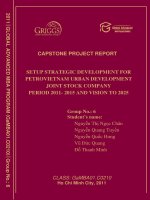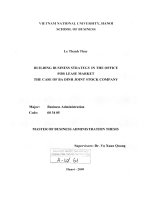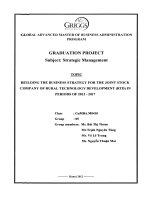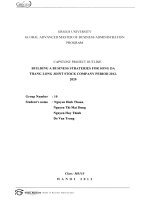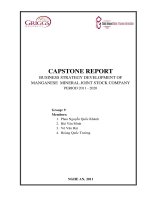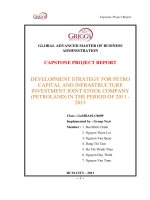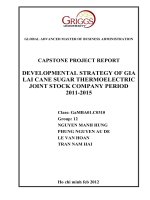Building development strategy of Nic human resource consultant joint stock company - period of 2013-2017
Bạn đang xem bản rút gọn của tài liệu. Xem và tải ngay bản đầy đủ của tài liệu tại đây (1.62 MB, 85 trang )
GRIGGS UNIVERSITY
MASTER OF BUSINESS ADMINISTRATION CURRICULUM
CAPSTONE PROJECT REPORT
BUILDING DEVELOPMENT STRATEGY OF NIC
HUMAN RESOURCE CONSULTANT JOINT STOCK
COMPANY - PERIOD OF 2013-2017
GROUP 9
Le Hong Diep (Group Leader)
Vu Trong Tuan
Nguyen Baa Long
Tran Ngoc Hung
Duong Van Tuan
Class: GAMBA M0111
HA NOI 11-2012
COMMITMENT
Members of Group 9 – MBA M0111 Class commits that the project:
“Building development strategy of NIC HUMAN RESOURCE CONSULTANT
JOINT STOCK COMPANY during 2013-2017 period” is the subject chosen to
study by our group. Data relating to NIC HR Consultant Joint Stock Company is
provided by the NIC.
Until the present time, this is the first time this subject has been studied. Our
group’s members don’t have any conflict of interest in the company.
Ha noi15
th
November 2012
Performance Members:
Le Hong Diep (Group leader)
Vu Trong Tuan
Nguyen Ba Long
Tran Ngoc Hung
Duong Van Tuan
ACKNOWLEDGEMENT
We would like to deeply thank the NIC Human Resource Consultant Joint
Stock Company for supporting us enthusiastically in data provision process as well
as meetings to make the business development strategy. In particular, we would like
to sincerely thank Mr. Than Van Hung, director of the NIC Human Resource
Consultant Joint Stock Company for providing us with the data on the company, the
data of the main competitors, the specialist data and contributed many ideas to help us
complete this report.
We also thank the most sincerely to professors, doctors of Master of
Business Administration (MBA) by Griggs University in collaboration with ETC
centre has dedicated teaching and guiding us throughout the training process. This
knowledge is necessary basic foundation to help us build this subject as well as
applying to the practical work. We also send a special thank to the University
Griggs’s academic council for guiding us in the research implementation process.
Ha noi15
th
November 2012
Performance Members:
Le Hong Diep (Group leader)
Vu Trong Tuan
Nguyen Ba Long
Tran Ngoc Hung
Duong Van Tuan
CONTENTS
COMMITMENT 1
ACKNOWLEDGEMENT 2
CONTENTS 3
LIST OF SYMBOLS AND ABBREVIATIONS 5
LIST OF FIGURES AND CHARTS 5
LIST OF TABLES 6
LIST OF TABLES 6
INTRODUCTION 1
CHAPTER 1: GENERAL THEORETICAL BASIS OF BUILDING
BUSINESS STRATEGY 4
1.1. Strategy and the role of strategic management 4
1.1.1. Definition of Strategic management 4
1.1.2. The role of business strategy 5
1.2 The strategic building process 5
1.2.1 Analysis of External environment 6
1.2.2. Analysis of competitors 14
1.3 Strategic analysis tools 17
1.3.1 External factor Evaluation (EFE) Matrix 17
1.3.2 Internal factor Evaluation (IFE) Matrix 19
1.3.3. Competitive Profile Matrix (CPM) 21
1.3.4 SWOT matrix 22
1.3.5 SPACE matrix 23
1.3.6 Decision period - Quantitative Strategic Planning Matrix (QSPM) 25
1.4 Building implementation roadmap and paying attention to the risks 26
CHAPTER 2: STRATEGIC FORMATION BASIS ANALYSIS OF NIC
HUMAN RESOURCE CONSULTING JOIN STOCK COMPANY 27
2.1 General introduction about NIC Human resource Consulting Join Stock
Company 27
2.1.1 Establishment and Development process of NIC Human resource Consulting
Join Stock Company 27
2.1.2 Vision, mission and core values 29
2.1.3 Organization Structure of NIC Human resource Consulting Join Stock Company
30
2.2 Analysis of external environmental factors 34
2.2.1 Analysis of the macro environment 34
2.2.2 Analysis of the industrial environment of NIC 38
2.2.3 Analysis of competitors of NIC - CPM matrix 43
2.2.4 External response ability Evaluation of NIC with EFE matrix (External Faclor
Evaluation) 46
2.3 Analysis of internal environment of NIC 48
2.3.1 Tangible resources 48
2.3.2 Intangible resources 50
2.3.3 Core competencies of NIC 55
2.3.4 Analysis of sustainable competitive advantage origin 55
2.3.5 Response ability assessment and Internal factor Evaluation (IFE) of NIC. 57
2.4 Summary of SWOT analysis of NIC 58
CHAPTER 3: PROPOSED STRATEGIC PLAN AND IMPLEMENTATION
SOLUTIONS OF NIC HUMAN RESOURCE CONSULTING JOIN STOCK
COMPANY – PERIOD 2013 - 2017 61
3.1 Forming business strategic plan for NIC Company 61
3.1.1 The strategic plans are formed from SWOT matrix 61
3.1.2 Analysis of SPACE maxtrix of NIC 62
3.2 Business strategy selection 64
3.2.1 QSPM matrix 65
3.2.2 Content of the selected strategy: 67
3.3 Some solutions to implement business strategies of NIC 69
3.3.1 Low cost strategy 69
3.3.2 Differentiation strategy 70
3.4 Strategic management roadmap and budget 71
3.4.1 Implementation roadmap 71
3.4.2 Implementation budget 73
CONCLUSION 75
LIST OF REFERENCES 77
LIST OF SYMBOLS AND ABBREVIATIONS
Figure 1-1: Strategic planning process 6
Figure 1-2: The determinants of competitiveness in the industry 13
Figure 1-3: Parts of the competitor analysis 14
Figure 2-1: Organization Chart of NIC 31
LIST OF FIGURES AND CHARTS
Chart 2-1 Outsourcing market share allocation in Vietnam 41
Chart 2-2: Market share in headhunting 42
Chart 2-3: Online recruitment market share in Vietnam 43
Chart 3-1: SPACE Matrix of NIC 64
LIST OF TABLES
Table 1-1: EFE Matrix 18
Table 1-7: IFE Matrix 20
Table 2-1: Outsourcing Market share statistics Unit:million VND 40
Table 2-2 Market share in headhunting 42
Table 2-3: Analysis of some basic indicators between NIC and the competitors 44
Table 2.4: Analysis of direct competitors of NIC - CPM 46
Table 2-5: EFE matrix of NIC. 47
Table 2.6: Economic indicators of NIC 48
Table 2.7 Training planning in 2011 51
Table 2-8: of sustainable competitive origin of NIC 56
Table 2-9: Internal factor Evaluation (IFE) of NIC 57
Table 2-10: Summary of SWOT analysis of NIC 58
Table 3-1: Caculating variables of SPACE 62
Table 3.2: To evaluate which plan is the most effective; we can look at the
following contents: 65
Table 3-3: Strategy and applied market 67
Table 3- 4: Strategic implementation roadmap of NIC – Period 2013 – 2017 72
Table 3- 5: Strategic implementation budget of NIC – Period 2013 - 2017 73
1
INTRODUCTION
1. Reasons for topic selection
In every age and in every socio-economic and political form, people are
always the center of the universe, human is always the priority of concerning
matters.
When human demands and other living conditions were highly satisfied, the
importance of human resources is the concern of people.
From the demands, since 2002, a number of enterprises operating in the field
of supplying, consulting the personnel solutions have played a small part in human
resources in Vietnam. NIC Human Resource Consulting., JSC is one of them.
NIC Human Resource Consulting., JSC (North Investment Consultant) was
established in 2002 and operated in the field of providing HR outsourcing services
such as:
Job consultancy and introduction, supply of the domestic labor and supply
personnel restructuring service…
In the International MBA program from the University of Griggs United
States with the topic: "Strategic Management", we - Group 9 - are assigned to
perform a team work with a project associated with a corporation to apply the
knowledge acquired during the training program in order to analyze and provide
solutions on the enterprise strategic management . For the above reasons as well as
one member working in NIC Human Resource Consulting., JSC, members in Group
9 has agreed to select the topic: “Building the Development strategy for NIC
Human Resource Consulting., JSC in the periods of 2013 – 2017” with the
expectation to contribute to the sustainable development of NIC Human Resource
Consulting., JSC in the current trend of regional integration and globalization.
2
2. Research objectives and applicability of the topic
- To systematize the problems of strategic management theory
- To analysis and assess of the company business situations in the context of
the Vietnamese economy.
- To support the company to identify their position in the market and then
plan to build and implement other strategies for sustainable development.
- To provide a number of strategic business solutions in the period 2013 - 2017.
3. Research objects and scope
- Objects: Building the Company's business strategy of NIC Human
Resource Consulting., JSC.
- Scope: Within the framework of the training program and in the
Vietnamese market in the period 2013 -2017.
4. Research Methodology
Quantitative and qualitative methodology is used as follows:
- Using research methods on available materials (secondary materials) to
examine the scope, structure and trends of the market.
- Using the analysis tools such as: Analysis of internal environment, external
environment, five competitive forces analysis, SWOT matrix, IFE matrix, EFE and
IE as lens to screen on the actual situations of the company operation to position the
strategic status of NIC in the competitive environment.
- Using various tools such as logical comparisons to build business strategy
of NIC to increase the competitiveness of the NIC in the Vietnamese market sector.
5. Expected results
Helps NIC to recognize their relative position in the competitive
environment and identify relationships of enterprise with stakeholders. On that
3
basis, develop a general strategy to increase competitiveness and the owner value
and be able to achieve above average profit.
6. Layout of the topic
In addition to the introduction and conclusion, the project consists of three
chapters:
Chapter 1: General theoretical basis of building business strategy
Chapter 2: Analysis of strategic formation basis of NIC Human Resource
Consultant Joint Stock Company
Chapter 3: Proposal strategy method and implementation solution of NIC
Human Resource Consultant Joint Stock Company during 2013 – 2017 Period
4
CHAPTER 1: GENERAL THEORETICAL BASIS OF BUILDING
BUSINESS STRATEGY
1.1. Strategy and the role of strategic management
1.1.1. Definition of Strategic management
Enterprises are normally formed and developed in accordance with certain
rules, and a lot of companies were strongly developed but a lot of companies were
failed and led to bankruptcy. What are the problems? The answer is: in the same
condition, enterprises which have good business strategies will be successful. So
what is the strategy? A strategy is simply a set of plans, methods and objectives in
order to bring above-average profits or to create the competitiveness over the
competitors. The strategy is associated with the objectives that the company
business and focused on planning to achieve those objectives. A good strategy
which is effectively implemented will help the managers and staffs at all levels to
determine objectives, identify action direction, and contribute to the company
success. On the contrary, a company which has no any strategy and no orientation
direction of operation is like “a ship without a sail”.
Although there are a lot of definitions of the strategy by the economists, each person
based different viewpoints and aspects.
In conclusion, the strategy can be defined generally as follows:
Business strategy is a series of commitments and actions that a company
uses to win a competitive advantage by exploiting the core capacity in a certain
market.
The fundamental issues of business strategy
Business strategy to identify three basic issues:
* Who will be the object to be served?
5
* Which demand will be satisfied?
* How to satisfy above demands?
1.1.2. The role of business strategy
Business strategy help the enterprise to realize clearly their goals, objectives,
direction which will serve as the premises and lodestar for all the business and
production activities of the enterprise.
Business strategy enables the enterprise to realize and capture all the
business opportunities, as well as help the organization to have methods to
proactively overcome all the threats on the competitive market.
Business strategy is contributed to the enhancement of the efficiency in using
resources, streghthen the competitive position of the organization to ensure the
sustainable development of enterprises. In addition, the business creates consistent
base for the formulation of policies and business decisions in accordance with the
market movements.
1.2 The strategic building process
Strategy building process is a chain of activities including: analysis,
hypothesis and the decisions and actions of an organization to be executed to
achieve strategic and sustainable competitive advantages, with the maximum profits
based on the limited resources.
6
Figure 1-1: Strategic planning process
Source: Strategic Management, the authors: Le The Gioi, Nguyen Thanh
Liem-Statistics Publisher in 2009)
Strategy formulation process can be divided into four stages:
1.2.1 Analysis of External environment
1.2.1.1 Analysis on the macro environment: PEST model
PEST model includes factors: Politics, Economics, Social Culture and
Technology. PEST model is more and better and become an indispensable standard
when studying the external environment of the organization.
Strategic function, mission and target of
enterprise (1)
Internal factor analysis
(S, W) (3)
External environment
analysis (O, T) (2)
Strategy selection (4)
Company level strategy (5)
Business level strategy and functional
department
Strategy implementation (6)
Check and evaluate the implementation results
Response
Information
7
Political and legal factors
It describes the manner which the organization impacts on the stakeholders
and vice versa.
The following criteria can be considered:
- The stabilization: the stability of the political institution, safety and
security.
- Tax policy: taxation impact significantly on organization profits.
- The relevant law: business law, labor law, antitrust law, investment law
- Policy: State strategic policies impact significantly on the organization.
Economic factors
Status of the macro-economic environment to determine the health and
prosperity of the economy always causes the impact on organizations and the
industry. Therefore, the organization needs to study the economic environment to
realize the change in trend and its strategic implications.
Economic environment shows the nature and direction of the economy in
which the organization operates. The economy impact on an organization can
change the ability to create value and its income. Four important factors should be
considered carefully such as the economic growth rate, interest rates, exchange rates
and inflation rate, the government's economic policies, the economic prospect in the
future.
Socio-cultural factors
Cultural values and social attitudes create the foundation of society so it
often leads to the changes and technological, political, legal, economic and
demographic conditions. This leads to the formation of social and cultural social
attitudes and cultural values. Thus, the social and cultural changes also create
opportunities and challenges.
8
Demographic environment:
Demographic environment related to the population, age structure,
geographic distribution, ethnic communities and the income distribution.
Changing in population structure, ethnic diversity, the increase in population
density, the complexity of geographical distribution is a factor of the macro
environment but it can also create opportunities as well as challenges.
Technological factors
With the current boom development in terms of depth and width,
environmental technology environment is important. Technology segments include
institutions, the activities are related to the creation of new knowledge, the knowledge
transfer to the outputs, products, processes and new materials, the surge explosion of
technology including creation and destruction, both opportunities and challenges.
One of the most important effects of technological change is that it can affect
the height of barriers to entry and reform the industry structure to the root.
1.2.1.2 Analysis on industrial environment: 5 competitive forces model of Michael
E. Porter
Competitive pressures of suppliers
The economist - M.E Porter mentioned about this issue in his book
"Competitive Strategy - page 64" as follows: The suppliers can show the bargaining
power with the buyers in the industry by threatening to increase prices or reduce
the quality of your products/services. Powerful suppliers can thereby squeeze
profits in a sector if the selling prices cannot increased to compensate the cost
increase.
Suppliers can put pressures on organizations through a number of factors:
- Number of suppliers: The number of suppliers will decide the competitive
pressure, their negotiating power with the sector and the organization. If there are
9
only few large-scale suppliers in the market, competitive pressures are created and
affected the entire industry's production and business activities.
Scale of suppliers: Large-scale suppliers will have more advantages to
customers.
- Appropriate number of substitute products: Pressure of suppliers will
increase if there are less appropriate substitutes.
- The number of retail customers compared to number of large customers:
Suppliers will put more pressured for retail customers.
- Important factors of products of the suppliers to the customer success: If the
products of suppliers are very important for the operation of the customers, the
suppliers will put greater pressure.
- The switching cost to replace the suppliers: The supplier will put a higher
pressure if the cost to customers switching to use other products is relatively high.
- The ability to penetrate the supplier to the customer's business: If the
supplier has the ability to enter the field of customers, they will have put a higher
pressure to customers.
Competitive pressures from substitute products
Substitutes which are the products and services can satisfy similar needs for
products and services in the industry.
The threat of substitute products increases when:
- The quality and efficiency of the substitutes are better than current products
- Low switching cost for buyers to change the products.
- Lower price of substitute products.
- Special products with high appreciation of the customers are less impacted
by this threat.
10
Competitive pressures from customers
M.E. Porter. “Competitive Strategy” - page 60: Customers compete with the
industry by price reduction, bargaining higher quality and more services and force
competitors to compete with each other. All of which causes the reduction of the
industry profitability.
Customer's power will increase when:
-Buying huge amounts comparing to sales of the seller
- Products or services purchased from the industry accounts for a large
proportion of the cost or the total procurement of the customers
The customer is a competitive pressure which can directly affect the entire
production and business activities of the industry.
- Products have no distinct characteristic.
- The switching cost for customers is low.
- Customers have low margins.
- Buyers have the ability to entry the industry of sellers.
- Products of the industry are not important for product and service quality of
the customers.
Competitive pressures from potential competitors
According ME Porter, potential competitors are not currently present in the
industry but can affect the industry in the future.
- The new entrants will have new production capacity, expectation of market
share resulted in price reduction and cost increase which leads to profit reduction.
Diversified companies often use their available resources.
More or less potential competitors, their strong or weak pressures depend on
following factors:
11
Barriers to entry: economies of scale, the cultural characteristics of the
products, capital requirements, switching costs, access to distribution channels, cost
disadvantages independent of scale, government policies.
- The reaction of existing competitors
- Price barriers to entry
- Barriers to entry due to experiences and scale
Competitive pressures from internal industry
Enterprises operating the industry will compete directly with each other to
create pressure on the industry and leads to create a competitive intension. The
competitive intension in the industry will increase when:
- High strategic interests: The competitors try to survive in the market.
- There are many competitors or competitors with similar power.
- High fixed costs or high storage costs: It is difficult to be able to switch to
other fields or other products.
- Difficult to have the opportunity to make differences or have low switching
costs: The competitors are similar on operation methodology, products, prices,
after-sale services.
- Sectors with slow growth or downturn: The competitors try to increase their
competitiveness to survive.
- Exit Barries: Same as the barriers to entry, exit barriers are factors which
make the withdrawal from the industry becomes more difficult (barriers of
technology, capital; constraints to labors and governments, relevant organizations;
strategy and plan constraints)
Analysis on Industry environment
A group of organizations providing products or services can substitute
closely together referred as an industry.
12
In that sector, organizations compete to each other to make above-average
profits. Industry environment analysis can clarify the following issues:
- The economic characteristics of the industry and its attractiveness
- The competitive forces in the industry
- The driving force that causes a change in the industry
- Sup-group the organizations in the industry
- The forces affecting the movement in the industry.
The managers can not establish a long-term orientation or a strategic decision
if they do not have a deep understanding of the strategic situation of the
organization.
The nature of competitive conditions that the organization has to face and the
approaches is to create the match between resources and capabilities with those
conditions.
Michael E. Porter - Professor of Harvard University had founded the
competitive forces model as follows:
13
Figure 1-2: The determinants of competitiveness in the industry
(Source: ME Porter, Competitive Strategy)
Five forces in this model are:
Therefore this model is the five competitive forces, including:
1. Potential competitors
2. Buyers
3. Suppliers
4. Substitutes
5. Existing competitors
This is also a useful tool to analyze the industry environment for recognizing
clearly opportunities and threats.
Potential competitors
Current competitors
(Internal industry
competition)
Buyers
Suppliers
Substitutes
Threat of new entrants
Threats of Substitute
products/services
Bargaining
powers of
buyers
Bargaining
powers of
suppliers
14
1.2.2. Analysis of competitors
According to the Economist ME Porter: "Competitive Strategy - page 86":
Competitive strategy requires positioning in order to maximize the organization
value to make the differences to other competitors. Therefore, the center of strategic
planning department is working on competitor analysis”
(15)
The goal of the competition analysis is to understand the preliminary on the
competitors and develop an entry or defense strategy or corporate with existing
competitors.
According M.E.Porter, analysis of competitors includes 4 parts :( see Figure
1.5) future goals, current strategy, assumptions and capabilities.
Factors impacted the competitors
Current and potential actions of the
competitors
FUTURE GOALS
At all levels of management and on
many aspects
CURRENT STRATEGY
How the organization competes?
THE RESPONSE OF COMPETITORS
Are the competitors satisfied the current position?
What Changes of actions or strategies will the competitors perform?
How is the competitor vulnerable?
What makes the competitors retaliaze in strongest and most effective way?
ASSUMPTIONS
About the industry itself
CAPABILITIES
Both strengths and weaknesses
Figure 1-3: Parts of the competitor analysis
15
Future goals
The determination of the competitors’ goal, or in other words, studying the
way that the competitors assess the target completion level is extremely important.
Knowing the goal of competitors helps the organizations to forecast its response to
strategic changes.
* The target can be at least as follows:
- The financial targets
- The belief or economic or non-economic values
- The organizational structure of the competitors
- Competitor’s attitude to risk
- System and encourage control system
- The accounting system
- The agreement level of the leadership and management
- The capacity of leaders and managers
- Management board structure
- Limited or extended commitments and contracts.
- The limitations of government, the law against competitors
- The limitations and constraints supported by the parent organization
- Analysis of competitor’s goals and targets
- The goal of the competitors and strategic positioning
Assumptions
These assumptions include two groups:
The assumption of competitors itself.
The assumption of the competitors and other organizations in the industry.
16
Questions about the assumptions of the competitors can be:
- Competitors believe about its relative position?
- Competitors have the history or a strong connection to the product or
design, geographical location, production, sales methods or not ?
- Competitors have cultural, regional or country tastes or not?
- Competitors have standard values or organization values or not?
- Competitors believe in future demands of the product and about the
significance of the trends in the industry.
- How the competitors assess the competitive capacities of other
competitors?
- Do the competitors believe in core values?
- Are the competitors’s assumptions feasible and objective?
- Background knowledge and experience of leaders and consulting relationships.
Current strategy
Analysis and evaluation the current strategy is extremely important. The
strategy of a competitor is operation policies, especially on business functions and
the connections among those functions.
The strategy can be public or privated or both types.
Capacities
M.E Porter, Competitive strategy: Actual appraisal of competitors’s
capacities is the final forecast in competitors’ analysis. Current objectives and
assumptions and strategies will impact on the time, nature and intensions and
possibilities of competitor’s response. The strengths and weaknesses will decide the
implementation capabilities and response to the strategies and deal with the
possible events in the industry or surrounding environment
17
Analysis on capabilities of the competitors, some issues need to be noted:
- Core capabilities
- Growth capabilities
- Quick response ability
- Adaptation ability with change
- Durable strength
- Attack ability
- Self-defense ability
1.3 Strategic analysis tools
1.3.1 External factor Evaluation (EFE) Matrix
EFE Matrix is to assess the external factors, generate and sumarize the
primary opportunities and threats affecting the organization’s operation to help the
managers to evaluate the response level of the organization with the opportunities
and threats and provide the views of external impact factors as opportunities or
threats for the organization. In order to use this matrix, 5 following steps should be
implemented:
Step 1: Make the list of 10- 20 factors of main opportunites and threats
affecting the success of the organization in the industry or the business field
Step 2: Clasify the importance score from 0.0 ( Not important) to 1.0 ( Very
important) for each factor. The important score for each factor depends on the
impact level to the industry/business field which the organization takes part in.
Total importance score should be equal to1.0.
Step 3: Determine the weight from 1 to 4 for each factor, weight of each factor
depends on the response level of each organization with each factors, 4: the best
response, 3: above-average response, 2: average response, 1: weak response.
18
Step 4: Multiple the importance score of each factor with the weight to
determine the scores of each factor
Step 5: Plus total scores of factors to determine the total scores of the matrix.
Evaluation: Total score of the matrix indepents on the scores of factors in the
matrix, 4 is highest score and 1 is lowest score.
If the total score is 4, the responses of enterprise with the opportunities and
threats is good.
If the total score is 2.5, the organization’s responses with the opportunities
and threats is average
If the total score is 1, the organization’s responses with the opportunities and
threats is weak.
Table 1-1: EFE Matrix
I
II
III
IV
X
No
External factors
Weight
Score for evaluating
the response abilities
of the organizations
with the
environment changes
Conversion
scores
1
2
3
…
n
Explanations of this table:
Column No. II: external factors have impact to the organization for
